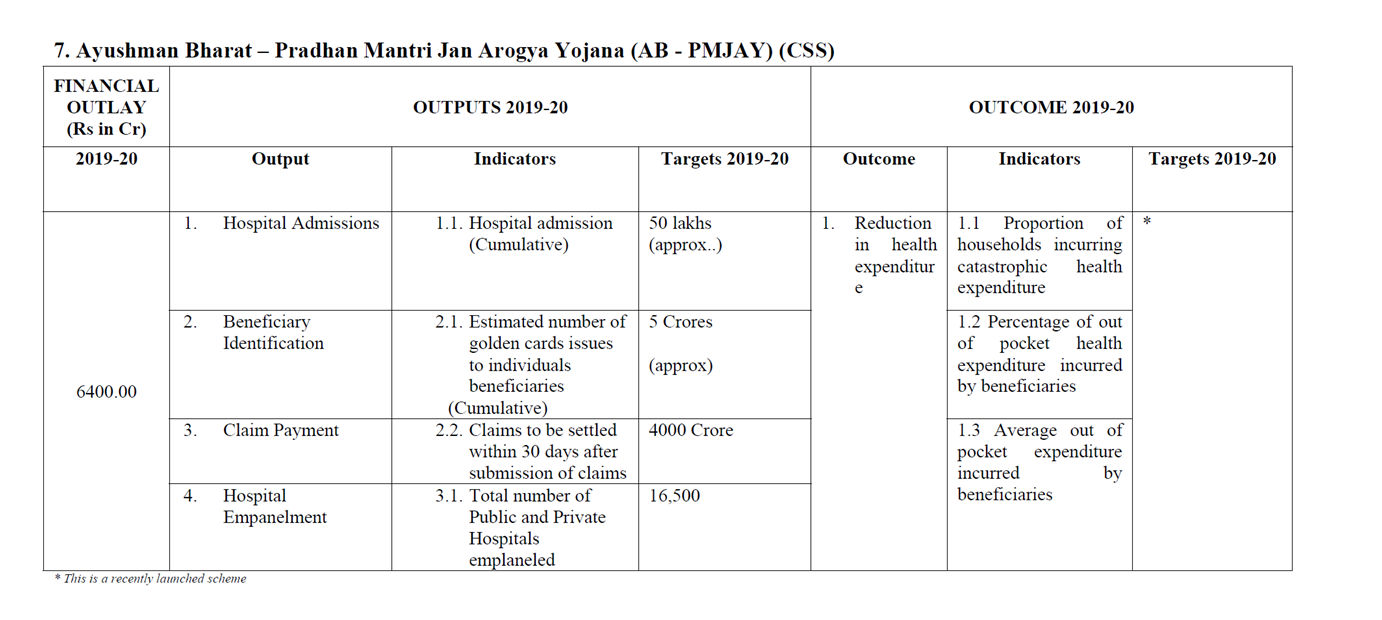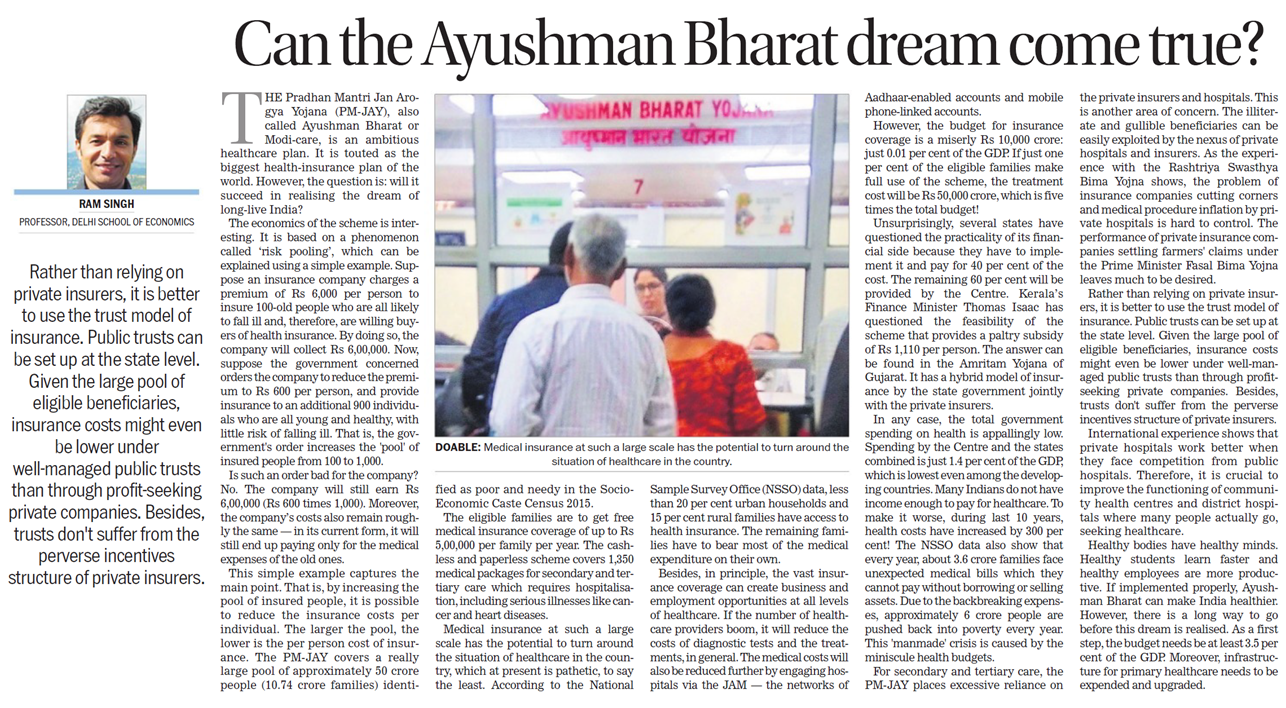Excellent study material for all civil services aspirants - begin learning - Kar ke dikhayenge!
CONCEPT – ayushman bharat (PM Jan Arogya Yojana (AB-PMJAY)
Read more on - Polity | Economy | Schemes | S&T | Environment
- What it is: The Ayushman Bharat AB means 'long live India' scheme. It is a progression towards promotive, preventive, curative, palliative and rehabilitative aspects of Universal Healthcare through
- access of Health and Wellness Centers (HWCs) at the primary level and (b) provision of financial protection for accessing curative care at the secondary and tertiary levels through engagement with both public and private sector. Also called PM-JAY.
- Meaning of terms:
- Promotive = enabling people take more control over their health status
- Preventive = care received to prevent diseases from occurring
- Curative = to cure patients, not just reduce immediate pain or suffering
- Palliative = relieve suffering in any major illness that is chronic and life-threatening
- Rehabilitative = to help patients recover and get back to leading normal lives
- World’s largest: It is expected that more than 10 crore families will be benefitted and NHPS may become the world’s largest Government funded health insurance scheme. It will incorporate the ongoing centrally sponsored schemes (CSS) – (1) Rashtriya Swasthya Bima Yojana (RSBY) and the (2) Senior Citizen Health Insurance Scheme (SCHIS).
- Details: It is a comprehensive scheme, as explained below.
- National scale – It is a national initiative launched as the part of National Health Policy 2017, in order to achieve the vision of Universal Health Coverage (UHC). It will meet the relevant Sustainable Development Goal (SDG) and its underlining commitment, which is “leave no one behind”.
- Focus – The scheme focuses on providing increased access to quality of healthcare, free medication and diagnostic services for people with low financial status. It mostly covers poor, deprived rural families and identified BPL (below poverty line) families from both urban and rural India defined as per Socio-Economic Caste Census (SECC) data. The aim is to ensure that the poor & needy do not fall back into poverty.
- Terminology – Ayushman Bharat (Modicare / NHPM) = HWCs + NHPS ( = PMJAY)
- HWCs – Establishment of Health and Wellness Centres: This is a means to deliver comprehensive primary care for all, especially for the underprivileged and vulnerable people, who cannot afford medical treatment due to the over-priced medicines and investigations. These centres will provide Comprehensive Primary Health Care (CPHC), covering both maternal and child health services and non-communicable diseases, including free essential drugs and diagnostic services. The first Health and Wellness Centre was launched by the PM at Jangla, Bijapur, Chhatisgarh on 14th April 2018. Target till 31-12-2022 = 1.5 lakh HWCs.
- NHPS – National Health Protection Scheme (NHPS): Under the scheme, every eligible family is entitled to an insurance benefit of up to INR 5 lakhs per year in any private (empanelled) or public hospital across the country. This enables beneficiary’s cashless treatment at any secondary and tertiary health care facility. This is based on the principle of co-operative federalism with states of India. For implementation of the scheme, states have to establish a State Health Agency (SHA). By June 2019, 23 lakh claims worth Rs.3077 crore had been settled.
- Number of Beneficiaries: It will target about 10.74 crore poor, deprived rural families and identified occupational category of urban workers' families as per the latest Socio-Economic Caste Census (SECC) data covering both rural and urban. The scheme is dynamic and aspirational and will update as per SECC data.
- National Health Authority: The NHA was set-up to implement the PM-JAY in India. It is an attached office of the Ministry, with functional autonomy. The NHA is governed by a Governing Board chaired by the Union Minister for Health and Family Welfare, and it has its own CEO.
- List of benefits in ABY: The list of various benefits in the PM - Jan Arogya Yojana is
- Rs.5 lakh cover: Ayushman Bharat - National Health Protection Mission (AB-NHPM) will have a defined benefit cover of Rs. 5 lakh per family per year (per family)
- Portable Benefits: Benefits of the scheme are portable across the country and a beneficiary covered under the scheme will be allowed to take cashless benefits from any public/private empanelled hospitals
- Entitlement-based: ABY-NHPM will be an entitlement based scheme with entitlement decided on the basis of deprivation criteria in the SECC database
- Both private and public: The beneficiaries can avail benefits in both public and empanelled private facilities
- Cost control through pre-decided rates: To control costs, the payments for treatment will be done on package rate (to be defined by the Government in advance) basis
- Flexibility to states: One of the core principles of Ayushman Bharat - National Health Protection Mission is to co-operative federalism and flexibility to states
- National Health Agency (NHA): For giving policy directions and fostering coordination between Centre and States, the NHA is set up. States would need to have State Health Agency (SHA) to implement the scheme.
- Escrow Account for funds transfer: To ensure that the funds reach SHA on time, the transfer of funds from Central Government through ABY – NHPM to State Health Agencies may be done through an escrow account directly.
- IT platform for smooth running and fraud control: In partnership with NITI Aayog, a robust, modular, scalable and interoperable IT platform will be made operational for paperless, cashless transactions.
- Financial impact on families: In-patient hospitalization expenditure in India has increased nearly 300% during last ten years (NSSO 2015). More than 80% of the expenditure are met by out of pocket (OOP). Rural households primarily depended on their 'household income / savings' (68%) and on 'borrowings' (25%), while urban households relied much more on their 'income / saving' (75%) for financing expenditure on hospitalizations, and on 'borrowings’ (18%). Out of pocket (OOP) expenditure in India is over 60% which leads to nearly 6 million families getting into poverty.
- How ABY-NHPM will help: It will impact the reduction of Out Of Pocket (OOP) by
- Increased benefit cover to nearly 40% of the population, (the poorest & vulnerable)
- Covering almost all secondary and many tertiary hospitalizations. (except a negative list)
- Coverage of Rs.5 lakh for each family, (no restriction of family size)
- Increased access to quality health and medication.
- Timely treatments, improvements in health outcomes, patient satisfaction, improvement in productivity and efficiency, job creation thus leading to improvement in quality of life.
- Funding: The expenditure incurred in premium payment to be shared between Central and State Governments in specified ratio as per Ministry of Finance guidelines.
- 60:40 for all states and UTs with their own legislature / 90:10 in NE states and the 3 Himalayan states of J&K, HP and Uttarakhand / 100% central funding for UTs without legislature.
- Total expenditure will depend on actual market determined premium paid in States/ UTs where AB-NHPM will be either implemented through insurance companies or via Trust/ Society mode. The central share of funds will be provided based on actual expenditure or premium ceiling (whichever is lower) in the ratio
- States would need to have State Health Agency (SHA) to implement the scheme.
- To ensure timely disbursement of funds from Central Government to State Health Agencies, an escrow account may be useddirectly. The State has to contribute its matching share of grants.
- Co-operative federalism and flexibility is given to states. There is provision to partner the States through co-alliance. This will ensure appropriate integration with the existing health insurance/ protection schemes.
- Criticism and limitations:
- Insurance based model – It is an insurance based model with the govt. paying the premium. Experts feel the right model for India is the one seen in Europe – vast expansion of public facilities, more public hospitals, more super specialities, more tertiary hospitals, more district level hospitals, more primary health centers, more doctors and nurses, more beds and freepublic health care.
- Scope for fraud – The government has called on companies to build an IT framework that can identify and trigger alerts for “suspicious” transactions (The Bhama Shah Scheme experience in Rajasthan was bad).
- Will help private sector make money – The quality and number of government hospitals is just not enough to cater to the massive demand that will arise. So many new private hospitals and dispensaries will come up. Is that the objective of the scheme? Many corporate hospitals have refused to join hands, too.
- Lack of hospitals and trained staff – The quality and number of hospitals in Tier 3 and Tier 4 towns and rurban areas is either very poor, or non-existent. So as the AB-PMJAY raises expectations and people rush for getting treated, a lack of hospitals can lead to frustration.
- Summary: The AB-PMJAY is a paradigm shift from sectorial, segmented and fragmented approach of service delivery through various national and State schemes to a bigger, more comprehensive and better converged and need based service delivery of secondary and tertiary care.
* Content sourced from free internet sources (publications, PIB site, international sites, etc.). Take your own subscriptions. Copyrights acknowledged.






















COMMENTS